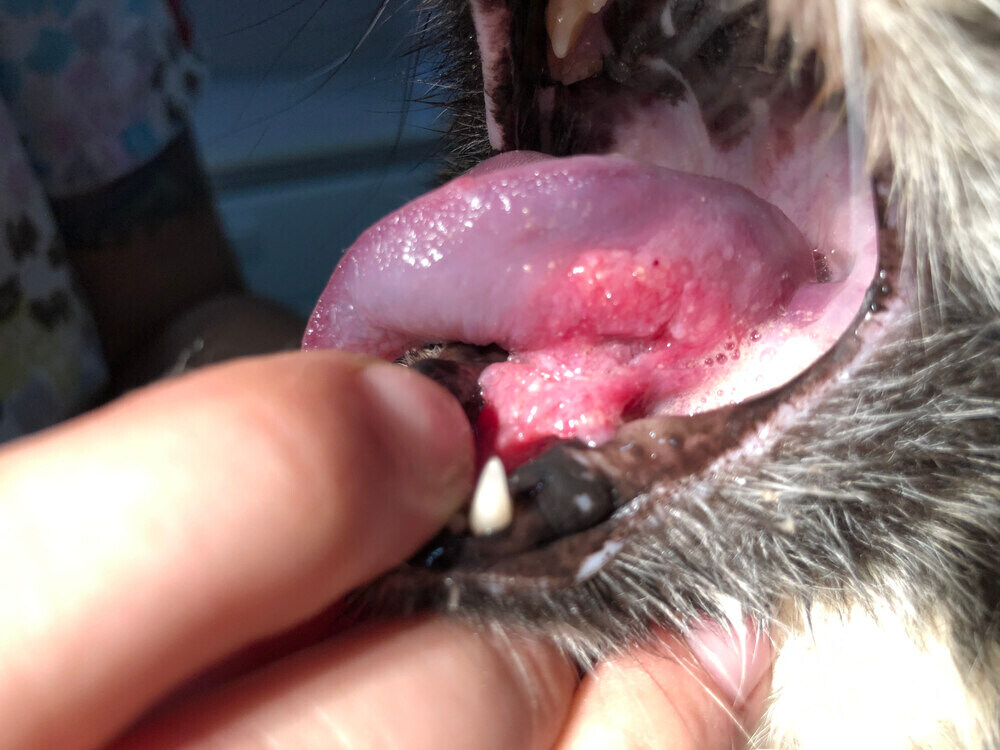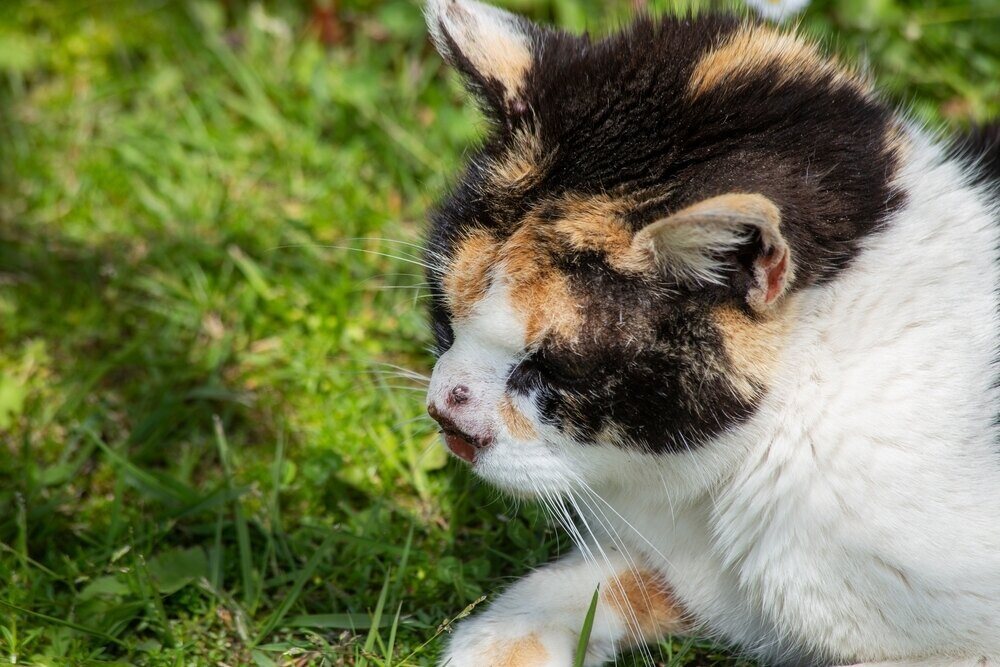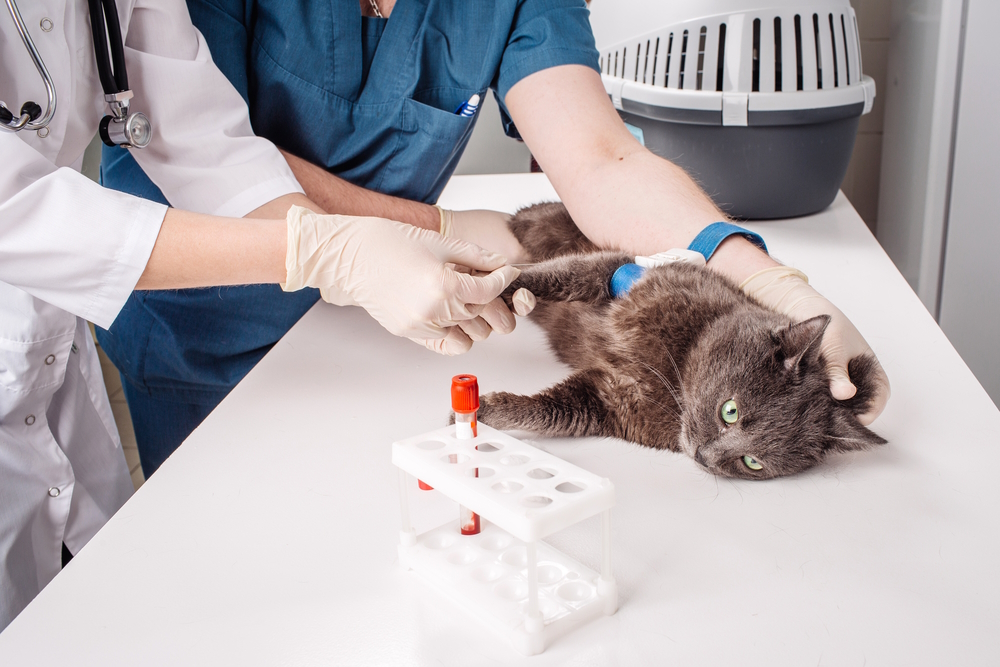Squamous cell carcinoma is a sort of domestically aggressive (malignant) most cancers that grows and spreads quickly within the neighboring tissues, together with on the bone degree.
This kind of most cancers typically happens because of solar publicity, particularly in cats with light-colored fur. Cats usually current on the vet clinic with pores and skin ulcers, particularly across the ears, eyes, and nostril. If surgical procedure is carried out in time, the possibilities of survival enhance.
On this article, you’ll study what squamous cell carcinoma is, the causes of its incidence, the scientific indicators, and what you are able to do in case your cat has squamous cell carcinoma.

What Is Squamous Cell Carcinoma?
Squamous cell carcinoma is a malignant most cancers, which means it may possibly unfold all through the affected tissues and may unfold to different areas. It’s an aggressive native most cancers, which grows rapidly and invades the neighboring tissues, together with the bone.
Probably the most generally affected cats are these between 7 and 15 years previous which have been uncovered to the solar for a very long time (outside or outdoor-indoor cats, particularly these with light-colored fur). Squamous cell carcinoma generally seems in non-pigmented areas uncovered to the solar. White cats are 13 instances extra liable to any such carcinoma in comparison with coloured cats.1
This kind of most cancers is situated in several areas of the top, corresponding to:
- Ear flaps (exterior pinna)
- Eyelids
- Pores and skin of the nostril
- Contained in the mouth (on the lips, beneath the tongue, mandible, tonsils, gums, and so forth.)
The prognosis can simply be confused with benign ulcers, gingivitis, or different dental illnesses, particularly when accompanied by poor dental well being.
In case your cat has pores and skin ulcers or bloody lesions, take them to the vet for an accurate prognosis and applicable therapy. Tumors situated on the nostril or ears might be observed extra simply by the proprietor, which results in earlier detection and simpler therapy.

What Are the Indicators of Squamous Cell Carcinoma in Cats?
The commonest space the place squamous cell carcinomas happen is the face, particularly the ears. Different high-risk areas are these with most solar publicity.
Scientific indicators of squamous cell carcinoma embrace:
- Irritation of the world
- Weeping sores
- Crusts
- Ulceration
- Native bleeding
Indicators of oral carcinoma might embrace:
- Lack of urge for food
- Weight reduction
- Swallowing with issue
- Dangerous breath
- Extreme salivation (generally with blood)
In some circumstances, squamous cell carcinoma might seem as a raised, purple space or cauliflower form. It additionally has two levels:
- Preliminary stage: Purple-pink nodular lesions seem. They’re agency in consistency, with raised edges. The carcinoma appears like a agency pores and skin nodule.
- Superior stage: The tumor has a variable, irregular diameter and is ulcerated. The superior section is usually related to regional adenopathy (enlarged native lymph nodes).
Squamous cell carcinomas often current as a solitary lesion (i.e., it happens in a single space). Nonetheless, there’s a sort of squamous cell carcinoma that is named Bowenoid carcinoma or Bowen’s illness.2 This carcinoma is a multicentric squamous cell carcinoma and happens in a number of areas of the physique, however just isn’t technically a metastatic most cancers.
When affecting the ears, squamous cell carcinoma often presents with darkish, crusting lesions on the ideas of the ears, which can bleed or trigger irritation.

What Causes Squamous Cell Carcinoma in Cats?
Any sort of tumor or most cancers is the results of uncontrolled multiplication of cells. What causes this lack of management does fluctuate and often a number of modifications need to occur to cells earlier than they are going to outcome within the progress of a tumor. Generally, the reason for squamous cell carcinoma in cats is the extended publicity of unprotected pores and skin areas (unpigmented, hairless areas) to UV rays. The UV rays trigger injury to the pores and skin cells. Cats between the ages of seven and 15 are mostly affected by any such most cancers.
Within the case of oral localization, squamous cell carcinoma represents roughly 80% of oral tumors reported in cats, affecting cats 12–13 years previous. In comparison with the cutaneous type, oral squamous cell carcinoma is extra aggressive and malignant.
How Is Squamous Cell Carcinoma Recognized in Cats?
An intensive normal examination will spotlight the presence of pores and skin lesions. If the vet suspects squamous cell carcinoma, they are going to advocate a cytological examination. Your cat will likely be put beneath native or normal anesthesia, and tumoral cells will likely be collected via high-quality needle aspiration. Nonetheless, for a definitive prognosis, a biopsy can also be advisable. This implies the vet will take away a chunk of the tumor or excise it utterly and ship it to the lab for prognosis.
Extra checks can be advisable, corresponding to blood checks (to evaluate the final state of well being) and chest X-rays (to see if the tumor has unfold to the lungs—i.e., if it has metastasized). Happily, metastasis is uncommon, however it may possibly unfold to the lungs, liver and kidneys. As well as, the vet also can advocate a CT scan to find out the extent of the illness, particularly in circumstances the place the most cancers happens within the mouth.

What Are the Remedy Choices for Squamous Cell Carcinoma in Cats?
Relying on the severity of the tumor and the way a lot it has unfold to the encircling tissues, the therapy choices for squamous cell carcinoma might be the next.
- Surgical intervention: On the whole, it is suggested that the excision of the tumor be completed utterly and broadly as a result of the recurrence fee for incomplete tumor resections is frequent. Within the case of oral carcinoma, that is typically extraordinarily difficult because of the location of the tumor, and the truth that it has often grown considerably by the point it’s detected. Remedy for oral carcinoma might contain a number of modalities, besides, the prognosis is usually poor.
- Radiation remedy: In circumstances the place the tumor is incompletely eliminated, radiotherapy may also help delay or stop relapse. If the tumor has not been surgically eliminated, radiation remedy may also help gradual tumor progress.
- Cryotherapy: Freezing the tumor or tumor margins could be a helpful method for plenty which might be troublesome to entry, notably oral carcinoma.
- Chemotherapy: This kind of remedy has minimal or no advantages in treating squamous cell most cancers in cats as a result of any such most cancers is taken into account proof against conventional chemotherapy. Nonetheless, there was some success with injecting chemotherapeutic medication immediately into the tumor itself.
- Tyrosine-kinase inhibitors (toceranib phosphate, e.g., Palladia): This kind of drug controls mobile features like replication, progress, differentiation, and so forth. Research have proven that cats with squamous cell carcinoma have an extended common survival time (123 days in comparison with 45 days in cats that haven’t been handled with toceranib).
- Different drugs: Sure drugs, corresponding to COX inhibitors (non-steroidal anti-inflammatories) or buprenorphine (artificial opioid), can enhance your cat’s consolation via the analgesic impact that they’ve. Oral antibiotics can be prescribed in case your cat has secondary infections.
How Do I Look after a Cat With Squamous Cell Carcinoma?
In case your vet recommends surgical excision of your cat’s squamous cell carcinoma, time is of the essence. The sooner the mass is eliminated, the upper the possibility of success. As soon as the tumor grows into deeper tissues, notably if it impacts the bone, prognosis is way much less favorable.
In case your cat has been recognized with oral squamous cell carcinoma, surgical procedure is probably not advisable, relying on the scale and site of the mass. You might be referred to a veterinary oncologist to debate the choices. Even in the event you go for palliative (finish of life) therapy, which could be very cheap with this type of the most cancers, it’s all the time good to know your choices.
Crucial think about caring for a cat with inoperable squamous cell carcinoma is monitoring their high quality of life. Anti-inflammatories and antibiotics will assist to maintain them snug, however finally, consuming and swallowing will turn out to be troublesome, and you will want to decide about euthanasia.


Continuously Requested Questions (FAQ)
What Triggers Most cancers in Cats?
A number of elements can set off most cancers in cats, together with UV rays, chemical compounds, weight-reduction plan, and so forth. Nonetheless, generally, the causes underlying the onset of most cancers in pets aren’t recognized. To assist scale back the dangers of most cancers and a spread of different illnesses, it is suggested to sterilize your cat, feed them a balanced weight-reduction plan, take them to periodic check-ups, and never expose them to chemical compounds like tobacco smoke. When you have a white cat, or one with white areas on their head, one of the best factor to do is defend them from the solar. Take into account conserving them indoors, and treating home windows with a UV-blocking movie to scale back publicity to sun-loving cats.
How Do You Feed a Cat With Squamous Cell Carcinoma?
In case your cat has been recognized with squamous cell carcinoma or another sort of most cancers, it’s best to feed them a weight-reduction plan that’s low in carbs as a result of they gasoline the most cancers cells. Your cat’s weight-reduction plan needs to be mentioned along with your veterinarian.


Conclusion
Squamous cell carcinoma is an aggressive most cancers that may unfold rapidly to the encircling tissues. This type of most cancers primarily impacts the ideas of the ears but additionally the lips, tongue, eyelids, gums, and so forth. The event of any such most cancers is often triggered by solar publicity, with white and short-haired cats being particularly affected. The everyday age of look of squamous cell carcinoma is 7–15 years.
Initially, the illness might be missed as a result of the pores and skin lesions are superficial. After advancing, although, squamous cell carcinoma produces native bleeding, everlasting crusting, necrosis, and secondary infections. When you discover any new lesions in your cat’s pores and skin that aren’t going away after per week or two, take them to see your. If the tumor is ready to be utterly eliminated, the prognosis is often fairly good. Nonetheless, in tumors which have invaded deeper tissues, or within the case of oral squamous cell carcinoma, the prognosis is mostly poor, with cats surviving 2–5 months, on common, after prognosis.
Featured Picture Credit score: M. Sam, Shutterstock



